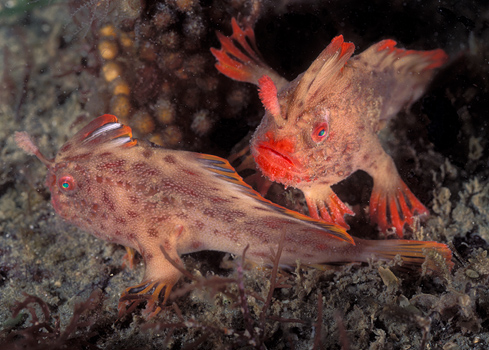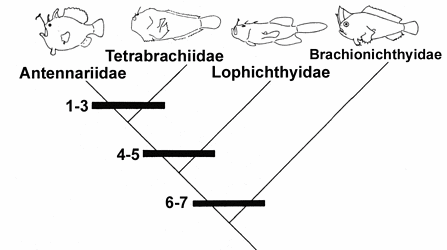Brachionichthyidae
Handfishes, warty anglerfishes
Theodore W. Pietsch


This tree diagram shows the relationships between several groups of organisms.
The root of the current tree connects the organisms featured in this tree to their containing group and the rest of the Tree of Life. The basal branching point in the tree represents the ancestor of the other groups in the tree. This ancestor diversified over time into several descendent subgroups, which are represented as internal nodes and terminal taxa to the right.

You can click on the root to travel down the Tree of Life all the way to the root of all Life, and you can click on the names of descendent subgroups to travel up the Tree of Life all the way to individual species.
For more information on ToL tree formatting, please see Interpreting the Tree or Classification. To learn more about phylogenetic trees, please visit our Phylogenetic Biology pages.
close boxIntroduction
The handfishes are a poorly known lophiiform family containing four described species in two genera: Brachionichthys and Sympterichthys. Handfishes are restricted to dispersed inshore marine habitats off southern Australia and primarily Tasmania. Like most other shallow-dwelling lophiiforms, they are exclusively benthic. Several species in the family are of conservation concern and listed as vulnerable to extinction by the Australian government (Last et al., 1983).
Australia's CSIRO has produced a QuickTime clip that outlines the conservation status of the spotted handfish (Brachionichthys hirsutus) and demonstrates the tetrapod-like locomotion of brachionichthyids.
Characteristics
Body deep; skin naked or covered with denticles. Second dorsal-spine joined to third by a membrane. Gill opening small, behind pectoral fin base. Dorsal-fin rays 15-18; anal-fin rays 7-10. Pelvic fin with one spine and 4 rays. A small illicium present just above mouth, function of which is unknown but does not appear to be used in luring potential prey. Attains 15 cm. Benthic, occurring in inshore waters at depths up to 60 m.
Discussion of Phylogenetic Relationships
Nothing is known of the phylogenetic relationships of the taxa within the Brachionichthyidae.
Relationship of Brachionichthyidae to Other Antennarioidei
The hypothesized relationships of the Antennarioidei as presented by Pietsch (1981) and Pietsch and Grobecker (1987). See below for character states.
The family Brachionichthyidae is classified as the basal sister taxon of a clade including the Lophichthyidae, Tetrabrachiidae, and Antennariidae; these four families forming the lophiiform suborder Antennarioidei (Pietsch, 1981; Pietsch and Grobecker, 1987). Monophyly of the suborder and the relationships within it are supported by a total of seven synapomorphies (see above cladogram):
- Posteromedial process of vomer emerging from ventral surface as a laterally compressed, keel-like structure, its ventral margin (as seen in lateral view) strongly convex;
- Postmaxillary process of premaxilla spatulate;
- Opercle similarly reduced in size;
- Ectopterygoid triradiate, a dorsal process overlapping the medial surface of metapterygoid;
- Proximal end of hypobranchials II and III deeply bifurcate;
- Interhyal with a medial, posterolaterally directed process that makes contact with the respective preopercle;
- Illicial pterygiophore and pterygiophore of third dorsal-fin spine with highly compressed, blade-like dorsal expansions.
Reproduction and Early Life History
Information on the reproduction of handfishes comes largely from monitoring programs of endangered or threatened species (Bruce et al., 1997; 1999). The spotted handfish (B. hirsutus) and red handfish (B. politus) spawn during September and October (Last and Bruce, 1997). Spawning in captivity is preceded by displays between male and female consisting of a variety of fin and body movements. Fertilization is external. It is not known if a single or multiple males fertilize the eggs of individual females in the wild. Egg masses of 80-250 eggs are spawned on the bottom around an isolated semi-rigid vertical object. The spotted handfish most commonly attach their eggs masses to stalked sea squirts (Sycozoa sp.); red handfish utilize algae (Caulerpa sp.). Handfish eggs are large (approximately 3–4 mm in diameter), orange in color, housed in individual flask-shaped envelopes, and interconnected in a single mass by a series of fine tubules and tendrils.
The female remains with the egg mass for seven to eight weeks until hatching. In captivity, females continue to feed during this period and have been observed probing the egg mass with their illicium and occasionally grasping the egg mass with their mouth.
Handfishes lack a pelagic larval stage, hatching fully formed juveniles (6–7 mm SL) that fall directly to the sea floor and remain near the spawning site.
Spotted handfish hatch in November and grow rapidly to 35–50 mm SL by the first year, and to 70–80 mm SL the second year. After two years the growth rate slows to only a few millimeters annually. Females reach maturity after 2-3 years at a size of 75–80 mm SL; male size at maturity remains unknown, however, the smallest observed captive-spawning male was 87 mm TL.
References
Bruce, B. D., M. A. Green, and P. R. Last. 1997. Developing captive husbandry techniques for spotted handfish, Brachionichthys hirsutus, and monitoring the 1996 spawning season. Final report to Endangered Species Unit, Environment Australia. CSIRO Div. Marine Research Hobart.
Bruce, B. D., M. A. Green, and P. R. Last. 1999. Aspects of the biology of the endangered spotted handfish, Brachionichthys hirsutus (Lophiiformes: Brachionichthyidae) off southern Australia. In: Proc. 5th Indo-Pac. Fish Conf., Noumea, 1997. In: SÚret B. and Sire, J.-Y., eds. Proc. 5th Indo-Pac. Fish Conf., Noumea, 1997: 369-380.
Last, P.R., and B.D. Bruce. 1997. Spotted handfish. Nature Australia. 25(7): 20-21.
Last, P. R., E. O. G. Scott, and F. H. Talbot. 1983. Fishes of Tasmania. Tasmanian Fisheries Development Authority, Hobart, viii + 563 pp.
Pietsch, T. W. 1981. The osteology and relationships of the anglerfish genus Tetrabrachium, with comments on lophiiform classification. U. S. Fish. Bull., 79(3): 387-419.
Pietsch, T. W., and D. B. Grobecker. 1987. Frogfishes of the World: Systematics, Zoogeography, and Behavioral Ecology. Stanford University Press, Stanford, xxii + 420 pp.
Information on the Internet
Australia's CSIRO information pamplets:- Red handfish (Brachionichthys politus)
- Spotted handfish (Brachionichthys hirsutus)
Title Illustrations

| Scientific Name | Brachionichthys politus (Richardson) |
|---|---|
| Location | Southeast Tasmania |
| Creator | David Hall |
| Acknowledgements | Underwater and Wildlife Photography, www.seaphotos.com |
| Specimen Condition | Live Specimen |
| Behavior | Guarding eggs |
| Sex | Male and Female |
| Copyright | © 2005 David Hall |
About This Page
Theodore W. Pietsch

University of Washington, Seattle, Washington, USA
Correspondence regarding this page should be directed to Theodore W. Pietsch at and Christopher P. Kenaley at
Page copyright © 2005 Theodore W. Pietsch
 Page: Tree of Life
Brachionichthyidae. Handfishes, warty anglerfishes.
Authored by
Theodore W. Pietsch.
The TEXT of this page is licensed under the
Creative Commons Attribution-NonCommercial License - Version 3.0. Note that images and other media
featured on this page are each governed by their own license, and they may or may not be available
for reuse. Click on an image or a media link to access the media data window, which provides the
relevant licensing information. For the general terms and conditions of ToL material reuse and
redistribution, please see the Tree of Life Copyright
Policies.
Page: Tree of Life
Brachionichthyidae. Handfishes, warty anglerfishes.
Authored by
Theodore W. Pietsch.
The TEXT of this page is licensed under the
Creative Commons Attribution-NonCommercial License - Version 3.0. Note that images and other media
featured on this page are each governed by their own license, and they may or may not be available
for reuse. Click on an image or a media link to access the media data window, which provides the
relevant licensing information. For the general terms and conditions of ToL material reuse and
redistribution, please see the Tree of Life Copyright
Policies.
- First online 28 October 2005
- Content changed 09 October 2007
Citing this page:
Pietsch, Theodore W. 2007. Brachionichthyidae. Handfishes, warty anglerfishes. Version 09 October 2007 (under construction). http://tolweb.org/Brachionichthyidae/21996/2007.10.09 in The Tree of Life Web Project, http://tolweb.org/








 Go to quick links
Go to quick search
Go to navigation for this section of the ToL site
Go to detailed links for the ToL site
Go to quick links
Go to quick search
Go to navigation for this section of the ToL site
Go to detailed links for the ToL site